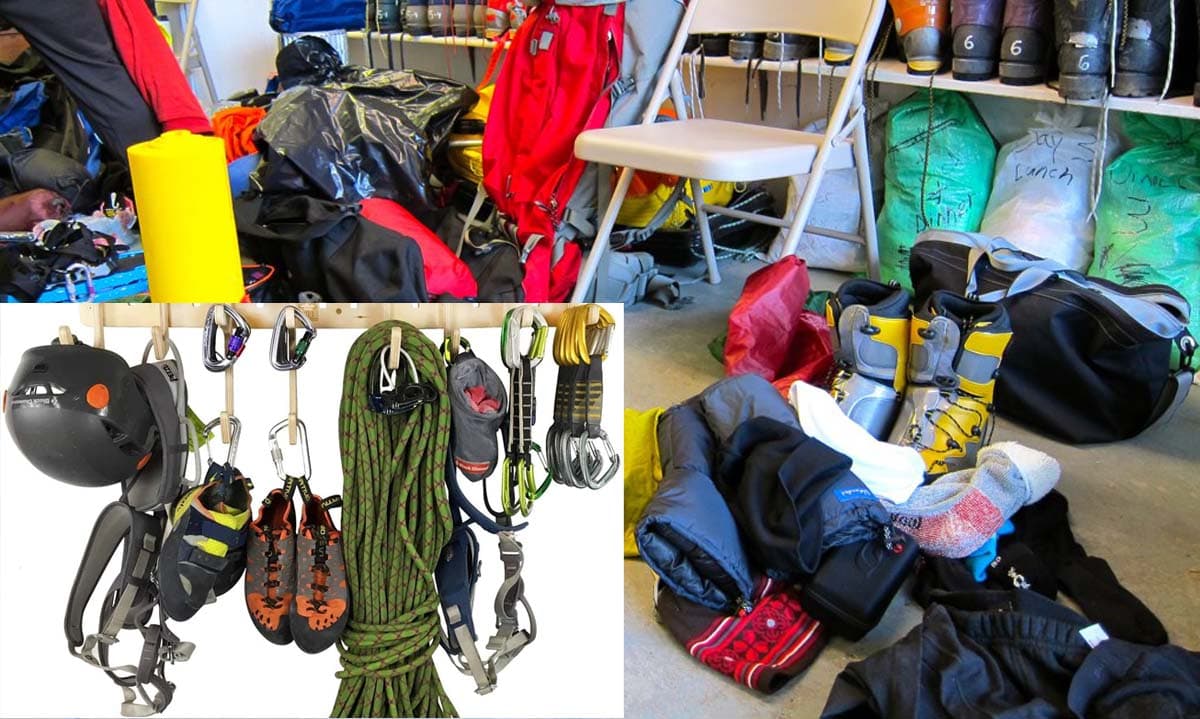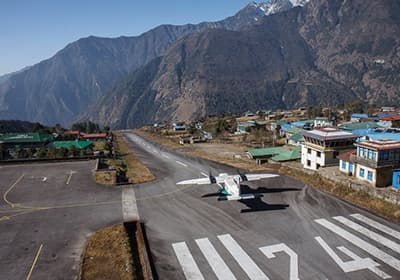Planning a climbing expedition to Nepal's towering peaks? We've helped countless mountaineers prepare for their Himalayan adventures, and we know that having the right gear can make the difference between summit success and turning back early.
This comprehensive guide is designed for serious climbers and mountaineers heading to Nepal's challenging peaks - from seasoned alpinists tackling Everest to intermediate climbers attempting their first 6,000-meter summit. We'll walk you through everything you need to pack for a safe and successful expedition in the world's highest mountains.
We'll cover the essential equipment for peak expeditions and climbing in Nepal across six critical categories. You'll learn about core climbing and mountaineering gear that forms the backbone of your equipment list, plus the clothing and layering systems that keep you warm and dry in extreme conditions. We'll also dive into the navigation and safety equipment that could save your life, along with camping essentials and technical hardware specific to high-altitude climbing.
Every piece of equipment we recommend has been tested in Nepal's harsh mountain environment. Our team has guided expeditions throughout the Himalayas, and we understand exactly what works - and what doesn't - when you're facing altitude, weather, and technical terrain that pushes both gear and climbers to their limits.
Core Climbing and Mountaineering Gear
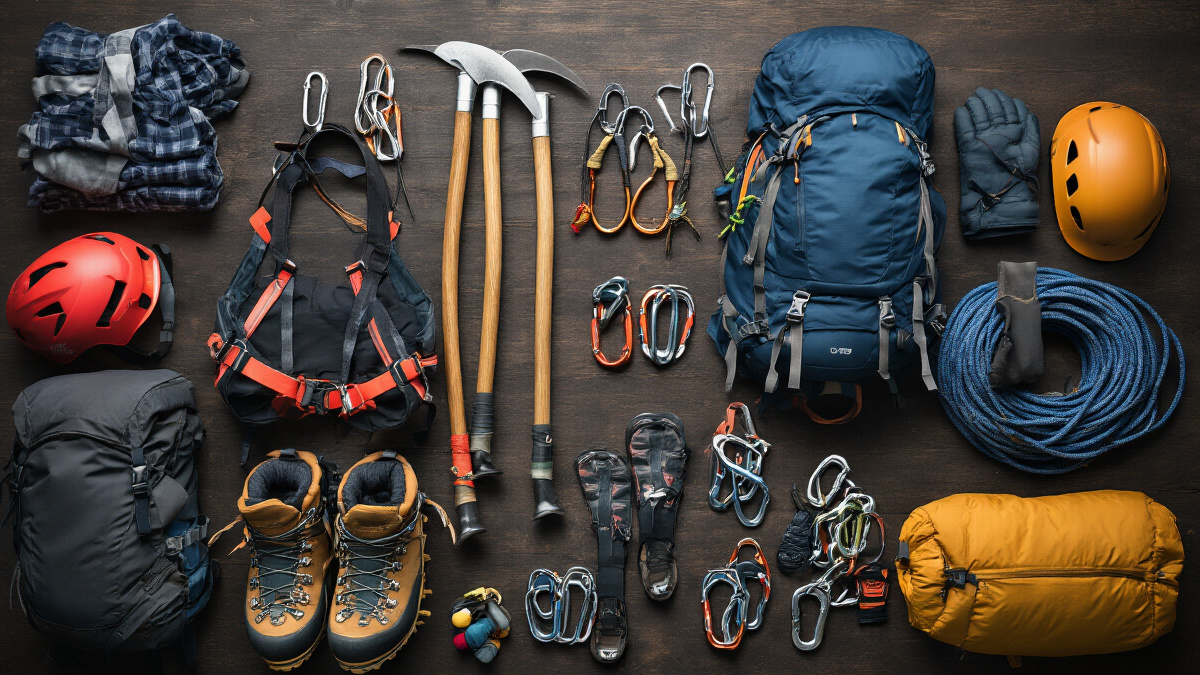
High-altitude climbing boots for extreme conditions
When we're talking about conquering Nepal's towering peaks, our feet become the foundation of success. We've learned through countless expeditions that choosing the right high-altitude boots can make the difference between summit glory and dangerous situations. Our experience has shown us that double boots are absolutely essential for anything above 6,000 meters, with the outer shell providing waterproof protection while the removable inner boot keeps our feet warm even in -40°C conditions.
We recommend boots with integrated gaiters and crampon compatibility as non-negotiable features. The Scarpa 8000 series and La Sportiva G2 SM have become our go-to choices after extensive field testing on Everest, Annapurna, and other challenging peaks. These boots offer the perfect balance of warmth, durability, and technical performance that we need when the stakes are highest.
Technical climbing helmets for rock and ice protection
Our heads house everything we need to make critical decisions on the mountain, so we never compromise on helmet quality. We've seen too many close calls with rockfall and ice chunks to treat head protection casually. Modern climbing helmets need to handle both impact and penetration protection, which is why we've moved toward hybrid construction helmets that combine in-mold technology with traditional hard shell durability.
We particularly value helmets with excellent ventilation systems since we often climb in varying temperatures throughout the day. The Petzl Meteor and Black Diamond Vector have proven themselves repeatedly in our expeditions, offering lightweight comfort without sacrificing protection. We always ensure our helmets fit properly with headlamps and maintain their certification standards.
Mountaineering harnesses for multi-pitch routes
Our harnesses become second skin during long climbing days, so comfort and functionality are paramount. We need harnesses that can handle the weight of our full rack while allowing us to move efficiently across technical terrain. We've found that adjustable leg loops are crucial since we're often putting on and removing layers throughout the day, and we need quick access to our gear.
We prefer harnesses with multiple gear loops and a belay loop rated for full strength. The Arc'teryx AR-395a and Petzl Adjama have consistently delivered the durability and comfort we demand during multi-day ascents. We also ensure our harnesses have drop-seat functionality for those necessary moments when nature calls at altitude.
Dynamic and static ropes for various climbing scenarios
Rope selection becomes critical when we're managing complex multi-pitch routes and rescue scenarios. We carry different rope types depending on our objectives - dynamic ropes for lead climbing and static ropes for hauling heavy loads or setting up technical rescue systems. Our rope inventory typically includes 9.5-10.5mm dynamic ropes for technical climbing and 10-11mm static ropes for fixed lines and heavy hauling.
We've learned that dry-treated ropes are essential in Nepal's unpredictable weather conditions. Brands like Mammut, Sterling, and BlueWater have consistently provided the reliability we need when our lives depend on the rope's performance. We always carry enough rope for our entire team plus emergency reserves, because running out of rope options at altitude simply isn't an option we can afford to face.
Essential Clothing and Layering Systems
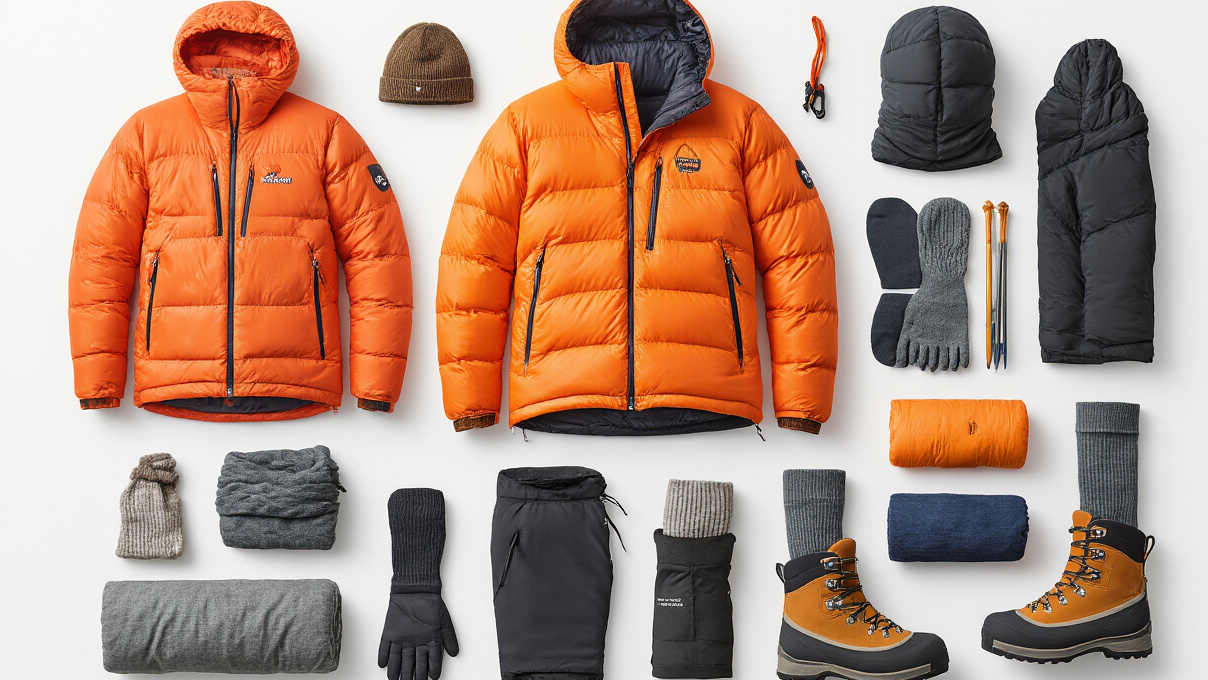
Base Layer Moisture-Wicking Fabrics for Temperature Regulation
When we're planning our next expedition to Nepal's towering peaks, we never underestimate the power of a quality base layer system. These foundation garments work tirelessly to keep our skin dry and comfortable, making the difference between a successful summit attempt and a miserable experience on the mountain.
Our preferred base layers feature synthetic materials like polyester or premium merino wool. Synthetic options excel at moving moisture away from our skin rapidly, while merino wool offers natural odor resistance and temperature regulation that we've come to rely on during extended expeditions. We typically pack both lightweight and midweight options, choosing based on expected temperatures and activity levels.
The fit matters tremendously in our experience. We look for base layers that hug our body without restricting movement, creating efficient moisture transfer while avoiding uncomfortable bunching under additional layers. Flatlock seams prevent chafing during long days on the mountain, and we always check for reinforced high-wear areas like underarms and collar zones.
We recommend packing at least two complete sets of base layers for any extended expedition. This allows us to have a dry backup system while washing and drying the other set. Smart fabric choices mean our base layers dry quickly at high altitude, where low humidity and intense UV radiation create challenging drying conditions.
Insulating Mid-Layers for Warmth Retention
Our mid-layer strategy forms the heart of our warmth management system during Nepal expeditions. These versatile pieces trap warm air while allowing moisture to escape, creating the perfect microclimate for sustained performance at altitude.
Down insulation remains our top choice for stationary activities and extreme cold conditions. We prefer 800-fill power down or higher, which provides exceptional warmth-to-weight ratios crucial for our pack weight management. Our down jackets feature box-baffle construction to prevent cold spots and maintain loft even after compression in our packs.
Synthetic insulation serves us well during active climbing and in wet conditions where down loses its effectiveness. Premium synthetic fills like PrimaLoft maintain insulating properties even when damp, giving us confidence during unpredictable Himalayan weather patterns. We often carry both types, switching based on conditions and activity levels.
Fleece layers offer incredible versatility in our mid-layer arsenal. High-quality fleece provides consistent warmth, breathes exceptionally well during high-output activities, and dries rapidly when wet. We prefer full-zip designs that allow precise temperature control as conditions change throughout our climbing day.
Our layering strategy involves carrying multiple mid-layer options of varying weights. This approach lets us fine-tune our insulation system as we move between different elevations and activity levels during our expedition.
Weather-Resistant Outer Shells for Wind and Precipitation Protection
Our outer shell selection represents the final defense against Nepal's harsh mountain weather. These technical garments must protect us from driving snow, fierce winds, and sudden storms while allowing our layering system to function effectively underneath.
Waterproof-breathable membranes like Gore-Tex Pro form the foundation of our shell selection. We prioritize three-layer construction for maximum durability against sharp rock and crampon damage common during technical climbing. The outer face fabric receives reinforcement in high-wear areas like shoulders, forearms, and seat areas, where pack straps and climbing harnesses create friction.
Our shell jackets feature large pit zips for rapid heat dumping during intense climbing sections. We look for helmet-compatible hoods with peripheral vision optimization, crucial for safety during complex technical sections. Multiple pocket configurations let us access essential items without removing gloves or compromising our belay stance.
Shell pants require different considerations for our climbing applications. We prefer full side zips for easy on-off over mountaineering boots and crampons. Integrated gaiters keep snow out of our boots, while scuff guards protect against crampon damage. The fit accommodates our harness system without restricting leg movement during high steps and mantling moves.
Ventilation becomes critical during high-output activities. Our preferred shells incorporate mesh-lined zips and strategic vent placement that work effectively even while wearing a climbing pack. This feature prevents dangerous overheating that leads to excessive moisture buildup within our layering system.
Navigation and Safety Equipment
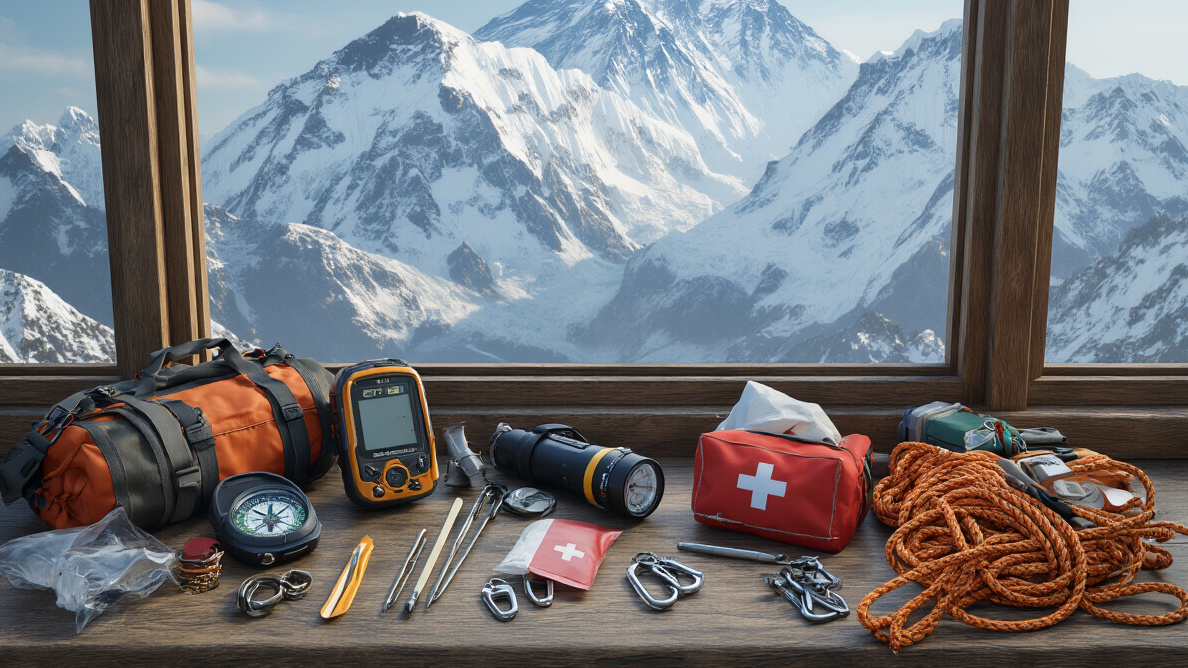
GPS devices and backup navigation tools
When we're planning expeditions in Nepal's remote mountains, reliable navigation becomes our lifeline. We always carry multiple GPS devices - our primary unit is typically a dedicated mountaineering GPS like the Garmin eTrex or GPSMAP series, which offers superior battery life and durability compared to smartphone apps. These devices work effectively even in extreme cold and provide accurate coordinates when visibility drops to zero.
We never rely on just one navigation method. Our backup arsenal includes a detailed topographic map of the region sealed in waterproof cases, along with a quality compass and altimeter. We've learned that electronic devices can fail at the worst moments, especially in Nepal's unpredictable weather conditions. Paper maps don't run out of battery or freeze up when temperatures plummet.
For our teams, we also pack route-finding apps on smartphones as a tertiary backup. Apps like Gaia GPS or AllTrails work offline and can be incredibly helpful for cross-referencing our position. We make sure our phones are protected in waterproof cases and carry multiple portable chargers to keep them operational.
Emergency communication devices for remote areas
Communication with base camps and rescue teams can mean the difference between life and death during our expeditions. We invest in satellite communication devices that function regardless of cellular coverage. Our go-to choice is typically a satellite messenger like the Garmin inReach series, which allows us to send GPS coordinates, text messages, and emergency SOS signals from anywhere in the world.
For larger expeditions, we carry satellite phones as our primary communication tool. These devices enable voice calls and can transmit weather updates, route changes, and emergency information to our support teams. We've found that models like the Iridium satellite phones work reliably even in deep valleys where other systems fail.
We also pack emergency beacons (PLBs - Personal Locator Beacons) as our last resort communication tool. These devices are designed specifically for life-threatening emergencies and transmit distress signals directly to international rescue coordination centers. Each team member carries one during high-risk sections of our climbs.
Two-way radios serve as our short-range communication solution between team members and base camps. We choose models with long battery life and weather-resistant construction, ensuring our teams can coordinate movements and share critical information throughout the expedition.
First aid kits specialized for high-altitude expeditions
Our high-altitude first aid kits go far beyond standard hiking supplies. We pack medications specifically for altitude-related illnesses, including acetazolamide (Diamox) for altitude sickness prevention, dexamethasone for severe cerebral edema, and nifedipine for pulmonary edema treatment. These medications can be life-saving when evacuation isn't immediately possible.
We include comprehensive wound care supplies suitable for serious injuries that might occur during technical climbing. Our kits contain hemostatic gauze for severe bleeding, SAM splints for fractures, and surgical tape that adheres in cold, wet conditions. We also pack instant cold packs, elastic bandages, and a variety of bandages and dressings for different injury types.
Pain management becomes crucial during multi-day expeditions, so we carry prescription pain relievers alongside over-the-counter options. Anti-inflammatory medications help with both pain and altitude adjustment. We include antibiotics for treating infections that could develop in unsanitary conditions far from medical facilities.
Our first aid kits also contain thermometers, pulse oximeters to monitor oxygen saturation levels, and blood pressure cuffs. These diagnostic tools help us assess team members' conditions and make informed decisions about continuing or retreating from dangerous situations.
Avalanche safety gear for snow and ice conditions
Avalanche safety equipment becomes non-negotiable when we're climbing in Nepal's snow-covered peaks. Every team member carries an avalanche transceiver (beacon), which transmits and receives signals to locate buried climbers. We use digital transceivers with multiple burial search capabilities and practice with them regularly before our expeditions.
Our avalanche probe extends at least 240cm and locks securely for efficient searching through snow debris. We choose probes with clear depth markings and quick-lock mechanisms that work reliably even when our hands are cold and clumsy. Carbon fiber models offer the best balance of strength and weight for our needs.
We carry compact avalanche shovels with sturdy blades and telescoping handles. These aren't just for avalanche rescue - we use them for digging tent platforms, snow walls, and emergency shelters. We look for shovels with D-grip handles and serrated blade edges that cut through hardened snow effectively.
Each climber wears an avalanche airbag backpack when crossing high-risk terrain. These packs deploy large balloons that help keep buried climbers near the surface of the avalanche debris. While they're not foolproof, they significantly increase survival chances in avalanche situations.
We also study avalanche forecasts and carry inclinometers to measure slope angles. Snow study kits help us assess snowpack stability, and we pack emergency bivouac gear specifically for avalanche scenarios, including emergency shelters and signaling devices for rescue teams.
Camping and Shelter Essentials
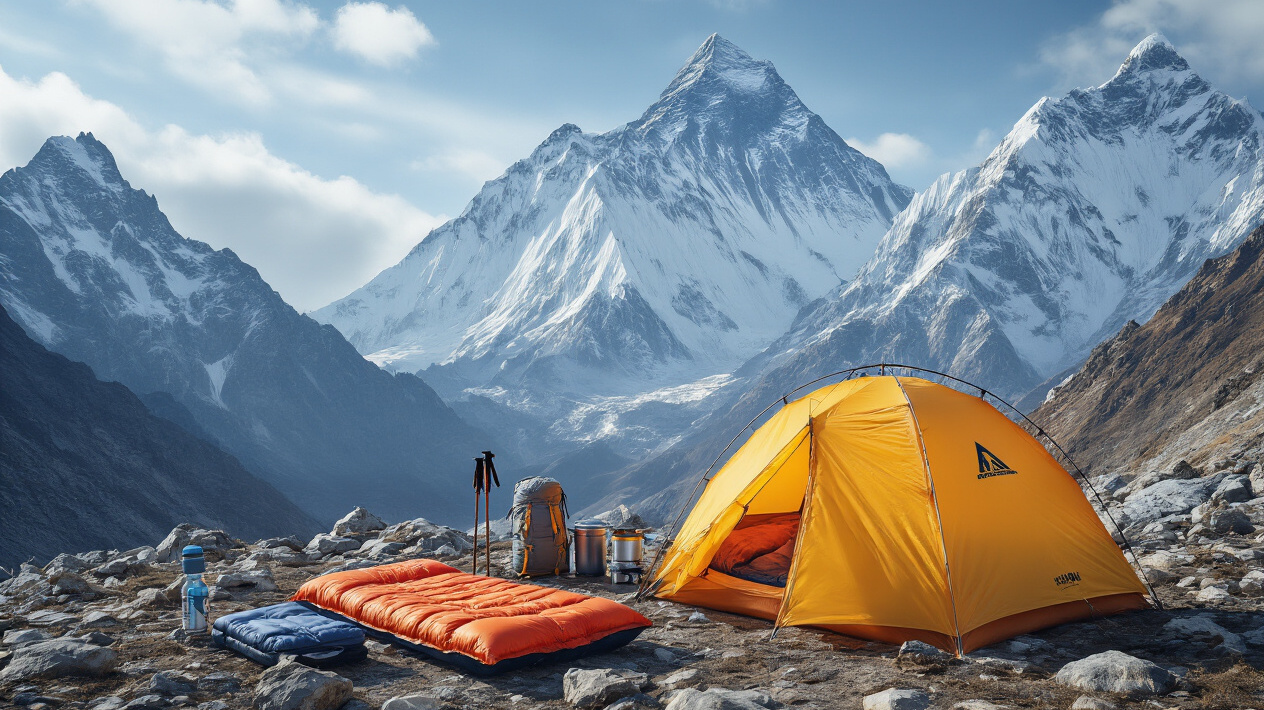
Four-Season Expedition Tents for Harsh Weather
We know that choosing the right expedition tent can mean the difference between life and death on Nepal's peaks. Our experience shows that four-season tents designed specifically for mountaineering expeditions are non-negotiable. These tents must withstand winds exceeding 100 mph, heavy snow loads, and extreme temperature variations.
We recommend tents with geodesic or semi-geodesic designs featuring multiple poles that create a strong, wind-resistant structure. The North Face VE 25 and Mountain Hardwear Trango series have proven themselves repeatedly on our expeditions. Look for tents with reinforced guy-out points, snow skirts, and vestibules large enough to store gear and cook safely.
Weight becomes critical above base camp, so we prefer lightweight materials like ripstop nylon with waterproof coatings. Double-wall construction provides better condensation management, which we've found essential during multi-day storms. The tent's packed size matters too – we need every inch of space in our packs optimized.
High-Performance Sleeping Bags Rated for Extreme Cold
Our sleeping bag selection focuses on temperature ratings that go well below what we expect to encounter. We typically recommend bags rated to -40°F (-40°C) for high-altitude expeditions, even when we don't anticipate temperatures dropping that low. This buffer zone has saved our lives during unexpected weather events.
Down insulation remains our preferred choice due to its superior warmth-to-weight ratio and compressibility. We use bags from Western Mountaineering, Feathered Friends, or Mountain Equipment with 800+ fill power down. The mummy design minimizes dead air space while maximizing warmth retention.
We always pair our sleeping bags with properly rated liners, which add 10-15 degrees of warmth while keeping the bag clean. Synthetic bags work as backups since they retain insulation properties when wet, though they're heavier and less compressible than down alternatives.
Insulated Sleeping Pads for Ground Protection
Ground insulation often gets overlooked, but we've learned that cold ground can rob body heat faster than cold air. We use closed-cell foam pads combined with inflatable, insulated pads for maximum protection. The Therm-a-Rest NeoAir X-Therm provides R-values exceeding 6.9, which we consider the minimum for high-altitude use.
We always carry backup pads because punctures happen at the worst possible moments. A simple closed-cell foam pad like the Ridge Rest can save your expedition when your primary pad fails. We've seen climbers develop hypothermia simply from inadequate ground insulation.
Pad width matters more than people realize. We prefer pads that accommodate shoulder width since cold spots around the torso area can wake you throughout the night. Proper sleep directly impacts our performance and decision-making abilities the next day.
Portable Cooking Systems for High-Altitude Fuel Efficiency
Cooking at altitude presents unique challenges that we've learned to navigate through experience. Liquid fuel stoves perform better than canister stoves above 15,000 feet because they maintain pressure in cold temperatures. We rely on MSR XGK-EX or Primus OmniLite stoves that burn multiple fuel types.
Fuel consumption increases dramatically with altitude and cold temperatures. We plan for 50% more fuel than we'd use at sea level. White gas burns cleanest and most efficiently, though we sometimes carry kerosene as backup since it's available locally in Nepal.
Wind protection becomes critical for fuel efficiency. We use comprehensive windscreen systems and often dig cooking pits or build snow walls. Our cooking setup includes lightweight titanium or aluminum pots with tight-fitting lids to maximize heat retention and minimize cooking times.
We've found that melting snow requires significantly more fuel than heating water, so we collect water whenever possible during the day. Pre-heating water in insulated bottles before cooking dinner saves both time and fuel during our evening routines.
Technical Climbing Hardware
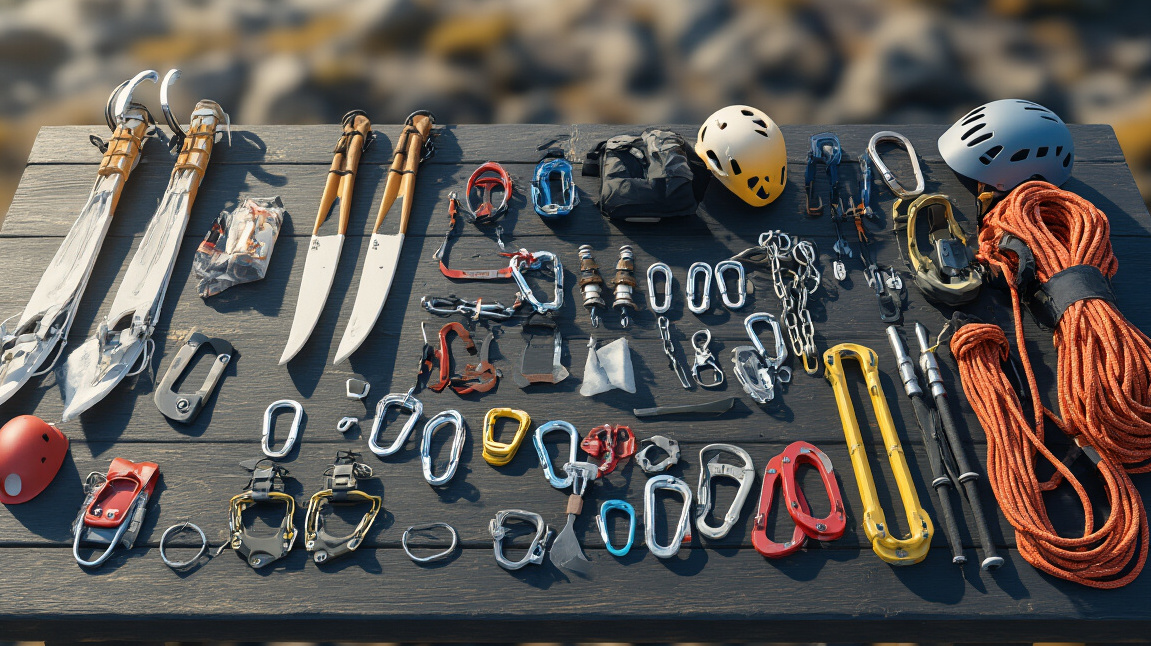
Ice Axes and Climbing Tools for Mixed Terrain
We've learned through countless expeditions that your ice axe serves as your lifeline on technical terrain. For Nepal's diverse climbing conditions, we recommend carrying both a general mountaineering axe (70-75cm) and a technical ice tool. Our teams typically use axes with steel heads and carbon fiber shafts to balance durability with weight savings. The adze should be sharp enough for step cutting, while the pick needs aggressive teeth for reliable placement in hard ice.
On mixed rock and ice routes, we prefer modular ice tools that accept different picks. Dry tooling picks work exceptionally well on the limestone common in Nepal's peaks, while pure ice picks excel on frozen waterfalls and couloirs. We always carry leashes or use tools with wrist loops - dropping an ice axe above 20,000 feet can end your expedition instantly.
Crampons Compatible with Mountaineering Boots
Our crampon selection depends entirely on the boots we're wearing and the terrain ahead. For technical routes requiring precise footwork, we choose rigid crampons with aggressive front points. These work best with mountaineering boots that have pronounced toe welts. We've had excellent results with 12-point crampons featuring both horizontal and vertical front points.
Step-in bindings offer the most secure attachment, but we always carry backup straps. Cold temperatures make plastic components brittle, and we've seen binding failures at critical moments. Anti-balling plates are absolutely essential - snow buildup under crampons has caused more slips than we care to remember. We inspect our crampons daily during expeditions, checking for loose screws, worn points, and proper binding function.
Protection Gear Including Pitons and Ice Screws
We carry a comprehensive rack tailored to Nepal's specific rock types. Limestone requires different protection than granite, so we pack accordingly. Our standard rack includes:
-
Ice screws: 13-22cm lengths, both aggressive thread and fine thread patterns
-
Pitons: Angles, Lost Arrows, and Leepers for limestone cracks
-
Snow pickets: Lightweight aluminum or carbon fiber for snow anchors
-
Rock protection: Cams and nuts sized for typical crack systems
We've found that Nepalese rock often requires larger gear than expected. The freeze-thaw cycles create wide cracks, so we pack more large cams and fewer small pieces. For ice protection, we prefer screws with color-coded hangers for quick identification in poor visibility.
Carabiners and Belay Devices for Rope Management
Our carabiner collection balances weight with functionality. We carry both locking and non-locking biners, with about 60% being non-locking for general use. HMS lockers work perfectly for belaying and rappelling, while smaller lockers serve for critical anchor points. We prefer lightweight aluminum biners for most applications, but carry a few steel biners for high-wear situations like fixed belays.
For belay devices, we use tube-style devices that work well in cold conditions and don't jam with icy ropes. Auto-locking devices can freeze in extreme cold, creating dangerous situations. We always carry backup belay methods - a simple hip belay or munter hitch can save your life when mechanical devices fail. Our rope management includes at least one progress capture pulley system for rescue scenarios, which unfortunately become necessary on challenging Nepalese peaks.
High-Altitude Specific Equipment
Supplemental Oxygen Systems for Extreme Elevation
When we're talking about peaks above 8,000 meters, oxygen becomes our lifeline. We recommend carrying personal oxygen systems that include lightweight bottles, regulators, and masks designed specifically for high-altitude climbing. Our experience shows that closed-circuit systems work best for sleeping, while open-circuit systems are ideal during active climbing phases.
We always pack backup regulators and extra masks because equipment failure at extreme altitude isn't just inconvenient—it's life-threatening. The oxygen flow rates we use typically range from 0.5 to 4 liters per minute, depending on activity level and individual acclimatization. We've found that starting oxygen use around 7,500 meters helps climbers maintain better decision-making abilities and reduces the risk of high-altitude cerebral edema.
Our team ensures each climber understands their oxygen system completely before departure. We practice mask changes, regulator adjustments, and bottle swaps during training sessions because these tasks become exponentially harder with thick gloves at -30°C.
Altitude Acclimatization Monitoring Devices
We rely on pulse oximeters to track blood oxygen saturation levels throughout our expeditions. These compact devices help us make informed decisions about ascent rates and rest day requirements. Our guides monitor each team member's readings twice daily, looking for patterns that indicate proper acclimatization versus potential altitude sickness.
Heart rate variability monitors have become game-changers in our high-altitude programs. We use them to assess autonomic nervous system stress, which often precedes visible altitude sickness symptoms. Sleep quality monitors integrated into our smartwatches provide valuable data about how well climbers are recovering during rest periods.
We also carry digital altimeters with barometric sensors to track elevation gain and weather pattern changes. These devices help us correlate physiological responses with specific altitude thresholds, allowing us to customize acclimatization schedules for individual climbers.
UV Protection Gear for Intense Mountain Sun Exposure
At high altitude, UV radiation increases dramatically—about 4% for every 300 meters of elevation gain. We equip our teams with glacier glasses featuring side shields and UV protection ratings of 99-100%. We carry backup pairs because losing eye protection at altitude can cause snow blindness within hours.
Our sunscreen protocol involves SPF 50+ products specifically formulated for extreme conditions. We apply it every two hours, even on cloudy days, because snow reflection can cause severe burns on unexpected areas like the underside of the nose and chin.
We use UV-protective lip balm with SPF 30 or higher, applying it frequently throughout the day. Cracked, sunburned lips at altitude heal poorly and can become infected. Our face masks and buffs provide additional protection during windy conditions when traditional sunscreen application becomes challenging.
Lightweight UV-protective clothing with UPF ratings covers areas that sunscreen might miss. We particularly focus on the back of the neck, wrists, and any skin gaps between gloves and jacket sleeves.
We've covered the essential gear categories that can make or break your climbing adventure in Nepal's spectacular mountains. From your base layers and technical climbing hardware to navigation tools and high-altitude equipment, each piece plays a crucial role in keeping you safe and comfortable on the peaks. Remember, investing in quality gear isn't just about performance – it's about your safety and success on some of the world's most challenging terrain.
At Luxury Holiday Nepal, we understand that proper preparation makes all the difference between a memorable expedition and a dangerous situation. Our experience guiding climbers through Nepal's peaks has shown us that the right equipment, combined with proper knowledge of how to use it, gives you the confidence to push your limits safely. Don't compromise on your gear list – your mountain adventure deserves the best preparation possible. Start gathering your equipment early, test everything thoroughly, and get ready for the climb of a lifetime in Nepal's incredible Himalayas.
If you need any further information, please contact us by email: at [email protected], Phone: at +977- 985 100 5129 (WhatsApp)

